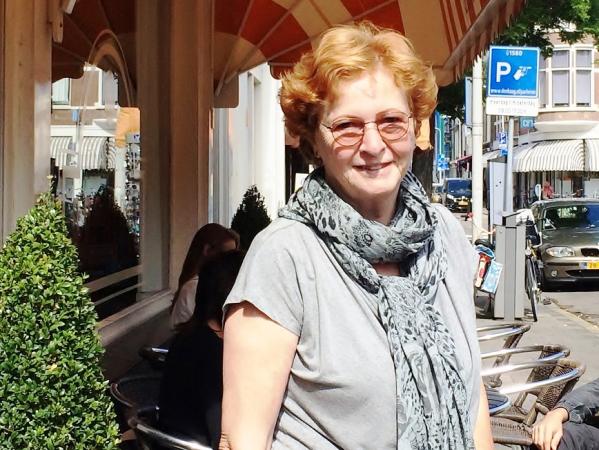This month, we interviewed Eveline Blitz, the Dutch author of “Bertha von Suttner: At The Cradle Of World Peace”. It was published in the Spring of 2014 and presented during the Bertha von Suttner Commemoration Week that took place in June of this year.
This small booklet which was published in Dutch, English and German tells the life story of Bertha von Suttner, author of the bestseller “Die Waffen Nieder” (1889), peace activist, and Nobel Peace Prize winner in 1905. Eight chapters, illustrated with twenty-four drawings in a cartoon-style format highlight the most important aspects of her life. Eveline Blitz wrote the text and artist Nita Veeren made the cartoons. Eveline Blitz reveals the story behind her book and tells us how she got involved with Bertha von Suttner and why she wanted the world to know about this remarkable, almost forgotten woman of history.
‘My own story about how I first learned about Bertha von Suttner started a long time ago in 2009.'
In 2009, Jozias van Aartsen, the mayor of The Hague, had three weeks to organize a special Conference on Afghanistan. He intended for all the delegates of the Conference to stay at the same Hotel since this would be most convenient for security related purposes. Former American Secretary of State, Hillary Clinton, would attend the Conference and declared during a press meeting: ‘When I come to The Hague, I will be staying in the Kurhaus Hotel, just like Bertha von Suttner did in 1899 when she attended the First Hague Peace Conference’ .
To me, Hillary Clinton is a woman who did a great job in furthering the cause of feminism worldwide and I wondered why she had said that. I never heard about Bertha von Suttner and wanted to know who she was. I assumed that the newspapers but pick up on Hillary Clinton’s comment and would write a news story about Bertha von Suttner during the days of the Conference, but to my surprise there was nothing published in the media on this subject.
I then decided to search for information about Bertha von Suttner on the internet as well as in libraries. Within a few weeks, I got to the bottom of the story and learned that she wrote a famous book ‘Die Waffen Nieder' (1889) to help the peace movement to become an international movement. Most importantly, I found out that she supported the initiative of the First Hague Peace Conference and how she personally helped to establish the Peace Palace a hundred years ago.
I was astonished that I, as a native of The Hague, had never heard of her. I then realized that Hillary Clinton must have mentioned her name to get the people of The Hague to do more to honor the founding mother of the city of international peace and justice.
I started discussing the story with family and friends and started to write letters to the local and national newspapers. I read in the newspaper that the Peace Palace would open a Visitors Centre on its premises and I wrote a letter to the mayor as well to the Dutch Carnegie Foundation to suggest that the Visitors Centre should be named after Bertha von Suttner. I heard back from the municipality of The Hague and they explained that this was not a decision for the municipality to make. Unfortunately, I never heard from the Carnegie Foundation. With the help of a friend, I managed to get in touch with the director of the Carnegie Foundation. He explained that is was impossible to name a building on the premises of the Peace Palace after a person since it would be unfair to other nations since their nationals would not be selected. I then got in touch with the municipality and they suggested to try to get a building in The Hague named after her. This turned out to be successful because in 2011, the NGO building at the Laan van Meerdervoort 70, was named the Bertha von Suttner Building.
Then the muncipality of The Hague and the Dutch Carnegie Foundation showed an interest in our action, particularly in light of the Centenary of the Peace Palace in 2013. In that context, activities like a mini-documentary about Bertha von Suttner, an exhibition, lectures, and a “Salon” in the Kurhaus Hotel took place. A statue was unveiled in the Peace Palace and a second statue was donated to the City of The Hague and its citizens.
The only thing that there was left to do was to get her story in the newspapers, which to me, still seemed the best way to reach a general audience. It was important to make the story simple and as accessible as possible. I wanted to use very little text and focus more on images. I felt the best format for another newspaper story was a cartoon series. I approached a well- known local newspaper in The Hague and fortunately, they were interested in the story. I also found a professional illustrator named Nita Veeren and we decided to make a pilot edition. The response was very positive and we decided to work out eight editions with each edition featuring three images. This meant that we had to break Bertha’s story in eight different sections that would be published on a weekly basis during the celebrations of the Peace Palace Centenary in 2013.
After the cartoon was featured in the local newspaper, I approached the Dutch Carnegie Foundation and asked if they were interested in putting together a small publication of my cartoon.
It all worked out and the book was published merely a year later. I am delighted that the Bertha Cartoon was published and will hopefully finds it way around the world just like I had intended it to.
The booklet was published in Dutch, English and German and is for sale at the Visitors Centre next to the gates of the Peace Palace.
